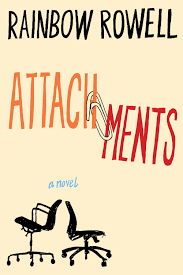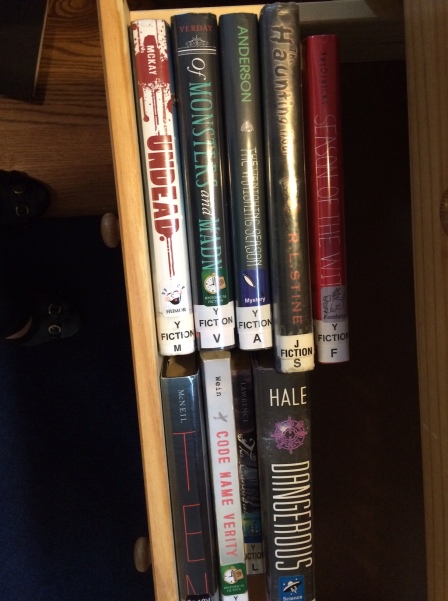I spent a windy, icy Sunday afternoon re-reading Attachments by Rainbow Rowell. Upon finishing, I decided that this book is one of my favorite love stories: funny, touching, and romantic in equal measure. I dare you not to fall in love with Beth and Lincoln!

+++++++++++++++++++++++++++++++++++++++++++++++++++++++++++++++++++++++
Originally posted on May 14, 2016:
This is the fifth Rainbow Rowell book I have finished in less than two weeks. I think it is possible that I have moved from a fan of her work to a super-fan; a title I will proudly embrace. Since I have reviewed all of her books on this blog, I am giving her her own tag “Rainbow Rowell” so that other fans of her work can find all of my posts in one place. (Note: I purposely decided not to separate out her adult novels from her young adult novels since — speaking as the mother of a teenager — I believe them to be mild enough for teen audiences.)
Attachments is the story told from the point of view of Lincoln, a twenty-something man in Nebraska living in 1999, who is deeply lonely and unable to find a path to happiness. After weathering a staggering heartbreak in college, Lincoln largely closed off from socializing, choosing to focus on school and work. After finishing grad school, he moved home to live with his mother (a delightfully funny hippie) and slowly let go of the things in life that gave him happiness: friends, dating, sports…in short, fun.
It is only after taking a job at a newspaper office that has just upgraded its staff to computers that Lincoln’s life slowly starts to open up. Night after night, Lincoln comes to work well after the reporters are gone in order to read all of their email and report to the boss who is misusing their work-site internet access. Without having to build relationships with his actual colleagues, Lincoln is able to build fictional ones with them; coming to know them through their emails and web searches.
It is the close relationship between two female employees at the paper that most intrigues Lincoln and, even well past the point of propriety, he finds himself drawn to their email conversations. Lincoln comes to “know” Jennifer and Beth as funny, loving, kind women and he comes to learn of their most intimate moments: loves, losses, and heartbreaks while never once even seeing their faces. He longs to meet them, but feels trapped. Getting to know them after reading their emails for almost a year, he argues to himself, would be starting out their friendship with a huge lie: like making money “off insider trading tips.” So he witnesses their friendship from afar and soon realizes that he is in love with Beth. And then, the magic starts!
What follows are a beautiful, if nontraditional, love story where the universe (or at least, the Internet) brings two people together who might have otherwise worked side-by-side without ever knowing one another.
Attachments is classified as a romance novel, but I feel that perhaps it is better categorized as a rom-com. Although the book is undoubtedly a love story, one of its most charming characteristics is its delightful sense of humor; and its quirky male narrator, Lincoln. In addition to being distinguished by its humor, the friendship/love story between Beth and Jennifer, which is central to the book, also lends more heartwarming appeal to what is already a unique and lovely novel.






